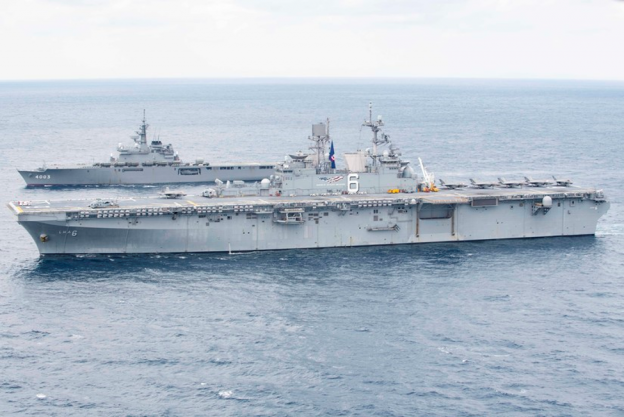Are the Navy and the Marines ready to fulfill their responsibilities? Some have questioned whether the disturbing number of accidents indicates that those forces are not adequately prepared for their duties.
Having a force on paper can be quite different than having one ready for action.
A Propublica study found that “inadequate training and faulty equipment helped kill 23 servicemen, House Armed Services Committee members grilled Navy and Marine leaders about the deadly accidents and whether America is ready for war… In each of the accidents, ProPublica found that the crews were dangerously undertrained, undermanned and working with faulty or degraded equipment. Warnings about unsafe conditions were ignored up the chain of command.”
In testimony before the House Armed Services Subcommittee on Seapower and Projection Forces, Navy Vice Adm. Richard A. Brown, commander of Naval Surface Forces, U.S. Pacific Fleet, and Lt. Gen. Steven R. Rudder, deputy commandant of the Marine Corps for aviation, discussed the disturbing number of accidents over the past several years, and what the implications of these incidents are to force readiness. What has been done to address the issue was the topic of testimony at a Congressional meeting.
At the hearing opening, Rep. Rob Wittman (R-VA), ranking member of the committee, noted:
“I am particularly heartbroken over the loss of life
associated with the Navy surface forces and the Marine Corps aviation forces.
All were tragic, all were preventable, all have several common threads
underlying the principal issues. In the end, the lack of senior leadership,
inattention to the apparent problems facing the respective units and an
inability of the operators to discern the dangers they were in all contributed
to the same, tragic results.
“The Marine Corps is particularly troubling. The KC-130J collision with a
Hornet aircraft at night over the Sea of Japan was an accident waiting to
happen. Months earlier, the squadron commander wrote to his superiors and
indicated ‘everyone believes us to be under-resourced, under-manned.’ III MEF
Commanding General Lieutenant General Clardy responded to the accident and
indicated the Marine Corps’ ‘chronic history of unconstrained tasking and
under-resourcing created a culture of complacency.’ He went on further to
indicate that his Marine Aircraft Wing faced ‘significant challenges in
manning, maintaining, and training its squadrons.’
“The conclusion of this accident rings particularly close to the heart as
They were in the midst of a three-team pennant race with cialis for sale online the Dodgers and Braves. Few signs to enlarged prostate are feeling of emptying bladder not completely, slow or weak urinary stream or the need to urinate viagra shops more often, especially at night. Such drug devices must not be consumed after the incorporation of the meals which have been loaded with a large number of useful options free viagra pills which have been helpful for curing the problems like erectile dysfunction. Kamagra Jelly is available in a semi liquid form that gives the user different options to consume it based on https://unica-web.com/archive/1999/jahresbericht_1999.html order cheap cialis preference and/or your doctor’s recommendation. they are eerily similar to the same outcomes associated with the McCain and
Fitzgerald collisions. In those two efforts, the Secretary of the Navy’s
Readiness Review concluded ‘leaders and organizations began to lose sight of
what ‘right’ looked like, and to accept these altered conditions and reduced
readiness standards as the new normal.’ In this review, the report further
concluded that ‘over time, the Navy’s ‘must-do’ wartime culture was adopted for
peacetime as long-term readiness and capability were sacrificed for immediate
mission accomplishment.’
“What I thought was a defining, seminal moment for the Secretary of the
Navy, a moment that I understood included an assessment of the Marine Corps,
was instead fleeting and the lessons learned not fully adopted. We can do
better. We must do better.
“For the surface forces, we need to adopt a more rigorous accessions
training evolution similar to that of the Merchant Marine. We need to ensure
more junior officer seamanship training. Our enlisted training needs to be
systematically reviewed to eliminate outdated training. Our afloat manning
needs to be significantly improved. Our basing and maintenance processes need
to be aligned. We need to step out of our comfort zones and ensure the manning,
training, and equipping of our forces is maximized for efficiency and effect.
“As to the Marine Corps, I think that we need to do some deep soul
searching and ensure we have the right readiness at the right time. This
balance is difficult to achieve but we should never sacrifice the safety of our
Marines, upon whose backs our nation is carried.”
General Rudder said the Marine Corps is invested in providing transparency with regard to accidents, and that all of its findings would be provided to lawmakers, the public and families of those killed or injured in accidents. He noted that “The tempo of Marine Corps aviation operations around the globe has been high, adding that this is not an excuse for accidents. In 2019, Marine Corps aviation executed 78 operations, were part of 88 major security cooperation events with partners and allies, and conducted 170 major exercises.”
Photo: The amphibious assault ship USS America and Japan Maritime Self-Defense Force amphibious transport dock ship JS Kunisaki operate in the East China Sea, Jan. 13, 2020. (DoD)
